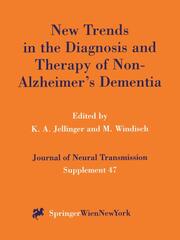Detailansicht
New Trends in the Diagnosis and Therapy of Non-Alzheimers Dementia
Journal of Neural Transmission. Supplementa 47
ISBN/EAN: 9783211828236
Umbreit-Nr.: 5743851
Sprache:
Englisch
Umfang: viii, 288 S., 24 s/w Illustr., 288 p. 24 illus.
Format in cm:
Einband:
kartoniertes Buch
Erschienen am 16.07.1996
Auflage: 1/1996
- Zusatztext
- Dementia is an acquired disorder of higher cerebral functions and cognition. Because of increasing life expectancy dementia poses a major health and socio economic problem. Alzheimer's disease accounts for 70-90% of mental decline in the elderly. Degenerative non-Alzheimer's dementi as are responsi ble for 7-30%. These include a variety of disorders clinically characterised by progressive cognitive dysfunction often combined with focal neurological def icits, e.g. Parkinson-plus syndromes, Lewy body dementia, lobar and multisys tem atrophies, other neurodegenerative disorders, and prion diseases. Often it is difficult to distinguish these illnesses from Alzheimer's disease and vascu lar dementia. In spite of considerable progress in molecular genetics, biochemistry, and neuropathology, the classification and pathogenesis of non-Alzheimer's dementias are still debatable. Diagnosis is frequently made only at postmor tem. Because disease markers are not available for the majority of non Alzheimer's dementias, consensus criteria for the identification of such diseas es are warranted. These criteria could serve at a basis for early diagnosis and distinction from other dementing disorders.
- Kurztext
- InhaltsangabeStructural basis of dementia in neurodegenerative disorders.- Cytoskeletal pathology in non-Alzheimer degenerative dementia: new lesions in Diffuse Lewy body disease, Pick's disease, and Corticobasal Degeneration.- The neuropathologic diagnostic criteria of frontal lobe dementia revisited. A study of ten consecutive cases.- Cognitive deficits in non-Alzheimer's degenerative diseases.- The neurochemistry of Alzheimer type, vascular type and mixed type dementias compared.- Clinical features of frontal lobe dementia in comparison to Alzheimer's disease.- Frontal lobe dementia and motor neuron disease.- Clinical and pathological characteristics of primary progressive aphasia and frontal dementia.- MR-imaging of non-Alzheimer's dementia.- Functional imaging techniques in the diagnosis of non-Alzheimer dementias.- Quantitative EEG in frontal lobe dementia.- Vascular dementia: perfusional and metabolic disturbances and effects of therapy.- The spectrum of depressive pseudo-dementia.- Molecular biology of APO E alleles in Alzheimer's and non-Alzheimer's dementias.- Transmissible cerebral amyloidosis.- Human prion diseases.- The survival response of mesencephalic dopaminergic neurons to the neurotrophins BDNF and NT-4 requires priming with serum: comparison with members of the TGF-? superfamily and characterization of the serum-free culture system.- Tau protein and apolipoprotein E in CSF diagnostics of Alzheimer's disease: impact on non-Alzheimer's dementia?.- Death of cultured telencephalon neurons induced by glutamate is reduced by the peptide derivative Cerebrolysin®.- Molecular regulation of the blood-brain barrier GLUT1 glucose transporter by brain-derived peptides.- Cerebrolysin® protects neurons from ischemia-induced loss of microtubule - associated protein 2.- The long-term effect of NGF, b-FGF and Cerebrolysin® on the spatial memory after fimbria-fornix lesion in rats.- The influence of Cerebrolysin® and E021 on spatial navigation of young rats.- Effects of Cerebrolysin® on cytoskeletal proteins after focal ischemia in rats.- The short-term influence of b-FGF, NGF and Cerebrolysin® on the memory impaired after fimbria-fornix lesion.- Brain tissue hydrolysate, Cerebrolysin®, acts on presynaptic adenosine receptors in the rat hippocampus.
